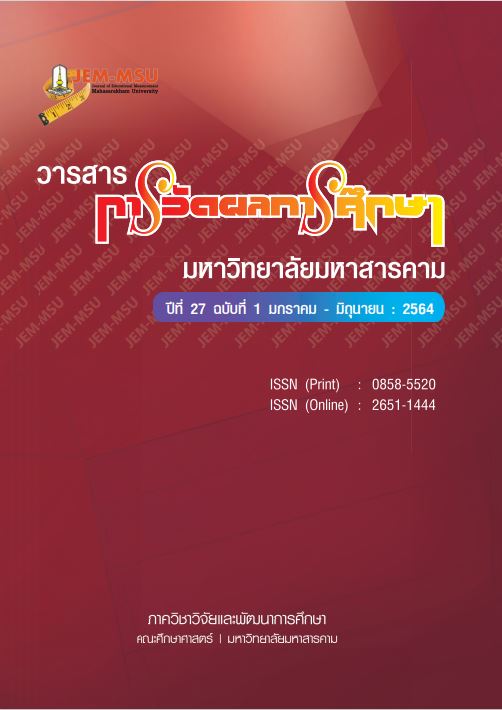Guessing and Development of Alternative IRT Models with Guessing
Main Article Content
Abstract
Guessing is an unavoidable problem for measurement and evaluation with multiple-choice tests. Although preliminary prevention is performed using various methods, it may not be perfect because the factors that cause the guessing may come from many reasons. These limitations became the rationale for developing different types of item response theory (IRT) model to measure the guessing. The issues presented in the article are as follows: 1) Guessing in multiple-choice tests has two types: random guessing and ability-based guessing; 2) Characteristics of test and test takers factors that affect guessing; 3) IRT models are Rasch, 2PL and 3PL models; 4) The alternative IRT models with guessing are AG, FG3PL, 2PLG, 3P-RH and 2PLE models, and 5) Comparison of differences between alternative IRT models with guessing.
Article Details
The content and information contained in the published article in the Journal of Educational Measurement Mahasarakham University represent the opinions and responsibilities of the authors directly. The editorial board of the journal is not necessarily in agreement with or responsible for any of the content.
The articles, data, content, images, etc. that have been published in the Journal of Educational Measurement Mahasarakham University are copyrighted by the journal. If any individual or organization wishes to reproduce or perform any actions involving the entirety or any part of the content, they must obtain written permission from the Journal of Educational Measurement Mahasarakham University.
References
ศิริชัย กาญจนวาสี. (2555). ทฤษฎีการทดสอบแนวใหม่ (Modern test theories). พิมพ์ครั้งที่ 4. กรุงเทพฯ: โรงพิมพ์แห่งจุฬาลงกรณ์มหาวิทยาลัย.
Andrich, D., & Marais, I. (2014). Person proficiency estimates in the dichotomous Rasch model when random guessing is removed from difficulty estimates of multiple choice items. Applied Psychological Measurement, 38(6), 432-449.
Baldiga, K. (2014). Gender differences in willingness to guess. Management Science, 60(2), 434-448.
Ben-Simon, A., Budescu, D., & Nevo, B. (1997). A comparative study of measures of partial knowledge in multiple-choice tests. Applied Psychological Measurement, 21(1), 65-88.
Bereby-Meyer, Y., Meyer, J., & Flascher, O. (2002). Prospect theory analysis of guessing in multiple choice tests. Journal of Behavioral Decision Making, 15(4), 313-327.
Bo, Y., Lewis, C., & Budescu, D. (2015). An option-based partial credit item response model. Quantitative Psychology Research, 89, 45-72.
Budescu, D., & Bo, Y. (2015). Analyzing test-taking behavior: decision theory meets psychometric theory. Psychometrika, 80(4), 1105-1122.
Cao, J., & Stokes, S. (2008). Bayesian IRT Guessing Models for Partial Guessing Behaviors. Psychometrika, 73(2), 209-230.
Croson, R., & Gneezy, U. (2009). Gender differences in preferences. Journal of Economic Literature, 47(2), 448-474.
Hambleton, R., Swaminathan, H., & Rogers, H. (1991). Fundamentals of item response theory. Newbury Park, CA: Sage.
Han, K. (2012). Fixing the c Parameter in the Three-Parameter Logistic Model. Practical Assessment, Research & Evaluation, 17(1), 1-24.
Hutchinson, T. P. (1991). Ability, partial information and guessing: Statistical modelling applied to multiple-choice tests. Rundle Mall, South Australia: Rumsby Scientific Publishing.
Lee, S., & Bolt, D. (2018). An Alternative to the 3PL: Using Asymmetric Item Characteristic Curves to Address Guessing Effects. Journal of Educational Measurement, 55(1), 90-111.
Lord, F. M. (1974). Estimation of latent ability and item parameters when there are omitted responses. Psychometrika, 39(2), 247-264.
Reckase, M. D. (2009). Multidimensional item response theory. New York, NY: Springer.
San Martín, E., Del Pino, G., & De Boeck, P. (2006). IRT models for ability-based guessing. Applied Psychological Measurement, 30(3), 183-203.
Smith, R. M. (1993). Guessing and the Rasch model. Rasch Measurement Transactions, 6(4), 262-263.
Thissen, D., & Wainer, H. (1982). Some standard errors in item response theory. Psychometrika, 47(4), 397-412.
Tsai, T., & Lin, C. (2015). Modeling Guessing Properties of Multiple-Choice Items in the Measurement of Political Knowledge. Paper was presented at the 2015 Asian Political Methodology Conference, Jan 9-10, 2015. Taipei, Taiwan.
Wise, S., & Kong, X. (2005). Response Time Effort: A New Measure of Examinee Motivation in Computer-Based Tests. Applied Measurement in Education, 18(2), 163-183.
Zhu, Z., Wang, C., & Tao, J. (2019). A two-parameter logistic extension model: an efficient variant of the three-parameter logistic model. Applied Psychological Measurement, 43(6), 449-463.


